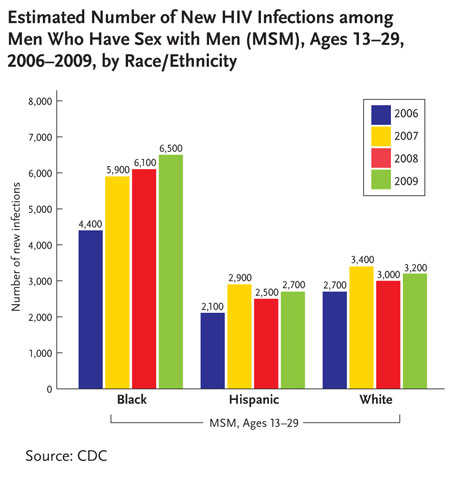Young, black gay and bisexual men experienced a 48 percent increase in new HIV infections from 2006 through 2009, according to new data released today by the Centers for Disease Control & Prevention.
The Atlanta-based CDC determined figures that show that in 2006, there were 4,400 HIV infections among black gay and bisexual men ages 13-29. The numbers jumped to 6,500 infections in 2009 within the same age group. This subpopulation represents the only subpopulation in the U.S. to experience a statistically significant increase during these three years.
“We are deeply concerned by the alarming rise in new HIV infections in young, black gay and bisexual men and the continued impact of HIV among young gay and bisexual men of all races,” said Jonathan Mermin, director of CDC’s Division of HIV/AIDS Prevention, in a statement.
“We cannot allow the health of a new generation of gay men to be lost to a preventable disease. It’s time to renew the focus on HIV among gay men and confront the homophobia and stigma that all too often accompany this disease.”
The staggering increase among black men who have sex with men (MSM) ages 13-29 may be attributed to several factors, according to the CDC:
• higher proportions of young, black MSM are unaware of their infection than MSM of other racial/ethnic groups
• stigma of HIV and homosexuality, which can hinder utilization of HIV prevention services
• limited access to health care, HIV testing and treatment; increased likelihood of having older sexual partners (who are more likely to be HIV infected), compared to MSM of other racial/ethnic groups
• higher rates of some sexually transmitted diseases among young black men, which can facilitate HIV transmission
• and under-estimating personal risk for HIV
In a conference call today with CDC officials, it was pointed out that individual behavior of young, black gay and bisexual men does not account for the high increase in new HIV infections.
Black, young MSM don’t necessarily have more sex partners or have more unprotected anal sex than gay and bisexual men of other races and ethnicities, said Joseph Prejean of the HIV Incidence and Case Surveillance Branch, CDC Division of HIV/AIDS Prevention. He is also the author of the report on estimates of new HIV infections in the U.S. for 2006-2009 published today in the online journal PLoS ONE.
“There are more complex factors — data shows they have higher rates of STDs. Black MSMs also have more cases of undiagnosed HIV and are more likely to transmit to others. There is also deep rooted stigma and less access to care,” he said.
The new CDC data — the first time the CDC has released multi-year data — also shows gay and bisexual men of all races and ethnicities still account for the highest increase in new HIV infections.
“Among MSM in 2009, white MSM represented the greatest number of new HIV infections (11,400), followed closely by black MSM (10,800) and Hispanic MSM (6,000),” according to the CDC.
Gay, bi men still account for most new HIV infections
In the U.S., the rate of new HIV infections remains relatively stable at 50,000 new infections a year between 2006-2009, the CDC reported. But the fact that gay and bisexual men still account for the highest numbers of new infections remains a concern of the CDC.
While gay and bisexual men of all races and ethnicities account for 2 percent of the country’s population, this group accounted for 61 percent of all new HIV infections in 2009.
“More than 30 years into the HIV epidemic, about 50,000 people in this country still become infected each year. Not only do men who have sex with men continue to account for most new infections, young gay and bisexual men are the only group in which infections are increasing, and this increase is particularly concerning among young African American MSM ,” said CDC Director Thomas Frieden.
“HIV infections can be prevented. By getting tested, reducing risky behaviors, and getting treatment, people can protect themselves and their loved ones.”
The new estimates show that in 2006 there were 48,600 new HIV infections, in 2007 there were 56,000, in 2008 there were 47,800 and in 2009 there were 48,100.

